Inside The New York Botanical Garden
Archive: July 2009
Posted in Exhibitions, The Edible Garden on July 31 2009, by Plant Talk
 |
Andrew Beckman is editorial director of gardening for Martha Stewart Living and co-host of the satellite radio show Homegrown. |
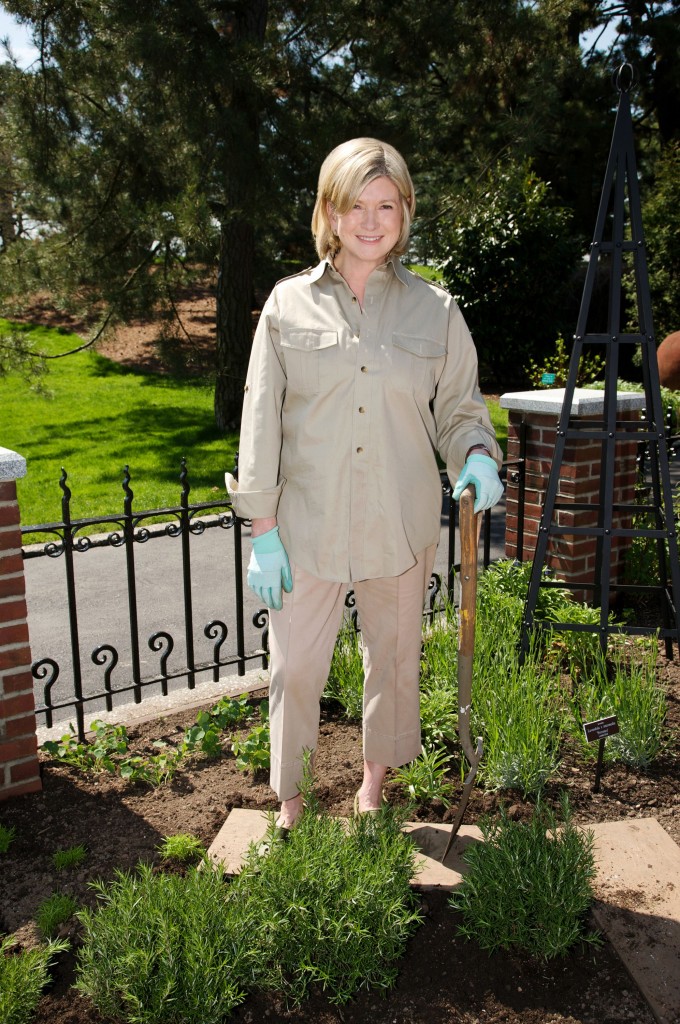 I must admit I groaned a little when Martha told me that she had agreed to redesign the herb garden at NYBG as part of The Edible Garden summer-long exhibitions. I’m not a big fan of herbs: They aren’t the most visually interesting plants, being mostly fine textured and green-gray. To top it off, the existing features at the location such as the shrubs, trees, and paths would dictate so much of the design.
I must admit I groaned a little when Martha told me that she had agreed to redesign the herb garden at NYBG as part of The Edible Garden summer-long exhibitions. I’m not a big fan of herbs: They aren’t the most visually interesting plants, being mostly fine textured and green-gray. To top it off, the existing features at the location such as the shrubs, trees, and paths would dictate so much of the design.
But after seeing the site and meeting with NYBG’s head horticulturists Todd Forrest and Margaret Falk, I sat down with Andrea Mason, our garden expert for the Martha television show, and Jodi Capobianco, Martha’s head gardener at the time. The three of us got stoked up on caffeine and sugar and got down to work. With a lot of laughter and talking over—and past—each other, we put together the plant list.
The plan included old standbys, Martha’s favorites, and some herbs from cuisines from other parts of the world. We plotted these onto the garden map, trying to mix up the textures and colors so the long borders to the sides of the garden would be as visually interesting as the parterre in the middle. Garden staff reviewed this first rough draft and suggested adding more silver plants and some edible flowers to spice up the design.
I revisited the site multiple times during this process, each time finding it smaller than it was in my memory. We asked Sal Gilbertie, owner of Gilbertie’s Herb Gardens in Westport, Conn., who donated the plants, for his advice on quantities and timing of the installation.
Read More
Posted in Exhibitions, Science, The Edible Garden on July 30 2009, by Plant Talk
 |
Scott A. Mori, Ph.D., Nathaniel Lord Britton Curator of Botany, has been studying New World rain forests at The New York Botanical Garden for over 30 years. As part of The Edible Garden, he will hold informal conversations about chocolate, Brazil nuts, and cashews—some of his research topics—during Café Scientifique on August 13. |
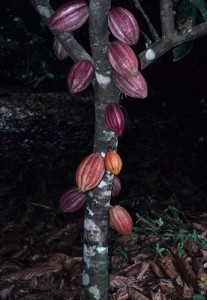 The chocolate that we eat and drink is one of the most complicated foods utilized by mankind. Not only did it co-evolve in the rain forests of the New World with still unidentified pollinators and with the help of animals that disperse its seeds, but it also undergoes an amazing transformation when it is processed, going from inedible, bitter seeds to the delicious chocolate products that most of us enjoy.
The chocolate that we eat and drink is one of the most complicated foods utilized by mankind. Not only did it co-evolve in the rain forests of the New World with still unidentified pollinators and with the help of animals that disperse its seeds, but it also undergoes an amazing transformation when it is processed, going from inedible, bitter seeds to the delicious chocolate products that most of us enjoy.
I became fascinated with the natural history and cultivation of chocolate while working for the Cocoa Research Institute in southern Bahia, Brazil, from 1978 to 1980. I directed a program of plant exploration in what was then, botanically, one of the least explored regions of the New World tropics. During those two years, I made 4,500 botanical collections, including many species new to science and many from cocoa plantations.
The scientific name of the chocolate tree is Theobroma cacao L. Theobroma means “food-of-the-gods” in Greek; cacao is derived from the Aztec common name chocolatl; and “L.” is the abbreviation for Linnaeus, the botanist who coined the scientific name of the chocolate tree. The genus Theobroma includes 22 species.
One of the unsolved mysteries of the natural history of chocolate trees is its pollinators. Most varieties of chocolate are self-incompatible, which means that pollination of the flowers of a given plant with pollen from the same plant does not yield fruit. There are, however, some varieties that are self-compatible—the single tree growing in the Enid A. Haupt Conservatory at NYBG is proof, because it sets fruit. Nevertheless, for most chocolate trees to produce fruit, pollen has to be moved from one tree to the next. This does not happen frequently in plantations, because the average tree produces between just 20 and 40 fruits each year from the thousands of flowers that open on the tree.
Thus, a limiting factor in the production of chocolate is successful pollination, and because this has economic implications there has been considerable research about how to increase the production of chocolate by enhancing pollination. Some researchers believe midges (minute, mosquito-like flies) are the pollinators of chocolate trees. But the complexity and relatively large size of chocolate flowers in comparison to the size of midges indicates that they might be occasional visitors rather than the true or only pollinators of chocolate.
Read More
Posted in Exhibitions, The Edible Garden on July 29 2009, by Plant Talk
 I entered the Garden through the Mosholu Gate on a beautiful July morning, with my refrigerated bag and freshly chilled ice blanket waiting in the trunk. My mission was to spend no more than $20 on fresh produce at the Greenmarket and head back to the Viking kitchen to preserve what I found. As I walked through the market stalls, I wished I had set a higher budget; cabbages, fresh berries, gorgeous tomatoes, greens of all sorts, and the season’s earliest apples all called out to me.
I entered the Garden through the Mosholu Gate on a beautiful July morning, with my refrigerated bag and freshly chilled ice blanket waiting in the trunk. My mission was to spend no more than $20 on fresh produce at the Greenmarket and head back to the Viking kitchen to preserve what I found. As I walked through the market stalls, I wished I had set a higher budget; cabbages, fresh berries, gorgeous tomatoes, greens of all sorts, and the season’s earliest apples all called out to me.
Eleven dollars bought me three pounds of amazingly sweet heirloom cherry tomatoes in all shapes and sizes. Another $9 was spent on plump, fresh blueberries and four crisp Empire apples. I did not count the delicious cinnamon-apple scone I purchased toward my budget—it was a necessary luxury.
All told, I spent about three hours cooking and canning. I find this work to be meditative and pleasant, and I’m always pleased to open a jar of something out of season when mid-winter comes around.
I hope that you will try this recipe below and stop by The Edible Garden Conservatory Kitchen on August 8 to see my home canning presentations at 1 and 3 p.m. I’ll teach you how to make your own fruit preserves and tomato sauce, and you can taste some of the fruits of my labor putting up this summer’s amazing local produce. On a dark and snowy February day, you’ll open a jar of something special that you made with love, and you’ll be glad you did!
Read More
Posted in Exhibitions, The Edible Garden on July 28 2009, by Plant Talk
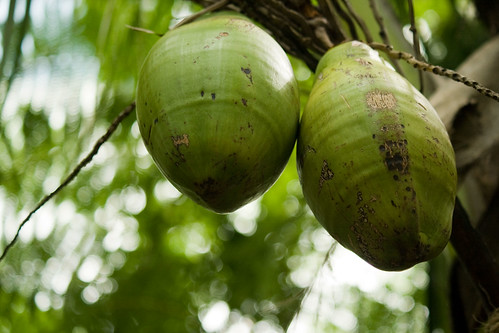
The coconut palm (Cocos nucifera) is often called the “tree of life” in honor of its varied uses. The hairy, brown-husked seeds contain a white meat that is a popular ingredient in sweet and savory recipes. It is grated and blended with water to create coconut milk and pressed to produce coconut oil—both useful cooking ingredients. The coconut water inside the seed is also a refreshing and highly nutritious drink. See this plant and more on the Edible Plant Tour during The Edible Garden.
Posted in Gardening Tips, The Edible Garden on July 27 2009, by Sonia Uyterhoeven
 |
Sonia Uyterhoeven is Gardener for Public Education. Join her each weekend for home gardening demonstrations on a variety of topics in the Home Gardening Center. |
 Edible flowers are not to everyone’s taste. Some are wonderfully fragrant and delicious, others are lemony, some are spicy and tangy, others taste green and weedy, and some even taste fishy. Edible flowers are a good way to add color and seasoning to your summer salads. They brighten up herb butters and dress up desserts. When added to a bowl of sugar or to a bottle of vinegar and left to steep for several weeks, they create inventive, tasty combinations.
Edible flowers are not to everyone’s taste. Some are wonderfully fragrant and delicious, others are lemony, some are spicy and tangy, others taste green and weedy, and some even taste fishy. Edible flowers are a good way to add color and seasoning to your summer salads. They brighten up herb butters and dress up desserts. When added to a bowl of sugar or to a bottle of vinegar and left to steep for several weeks, they create inventive, tasty combinations.
Some flowers need a little bit of preparation before they are ready to tickle your tongue. The sepals, stamens, and stigmas of some flowers such as borage (Borago), tulips (Tulipa), and daylilies (Hemerocallis) should be removed before eating—only the petals are eaten.
Pinks (Dianthus) and roses (Rosa) can have a bitter white edge at the base of the petal, which should be cut off before using. Some marigolds (Tagetes) are divine, but others are not—try the lemon-flavored Tagetes tenuifolia ‘‘Tangerine Gem’ and ‘Lemon Gem’.
For the best flavor, harvest flowers either when they are in bud or have just opened. Harvest on a dry day, mid-morning after the dew has evaporated and before it gets too hot. It is best to use flowers when they are fresh. They can be refrigerated for several days, but they do not dry or freeze well.
Read More
Posted in Exhibitions, The Edible Garden on July 24 2009, by Plant Talk
 |
Jessica Blohm is Interpretive Specialist for Public Education. |
 The Garden’s 250-acre National Historic Landmark landscape includes thousands of edible trees and plants. Through signs and audio interpretation, visitors can learn about 57 of these edible plants on the Edible Plant Tour during The Edible Garden.
The Garden’s 250-acre National Historic Landmark landscape includes thousands of edible trees and plants. Through signs and audio interpretation, visitors can learn about 57 of these edible plants on the Edible Plant Tour during The Edible Garden.
The tour features an array of plants, from the tropical coconut palm (Cocos nucifera) to our native sugar maple (Acer saccharum), source of that favorite breakfast topping, maple syrup. The tour also offers visitors a chance to share their stories and traditions about various plants and to listen to stories from other visitors, an exciting new feature.
Lotus (Nelumbo), pictured here, which has edible flowers, leaves, stems, and seeds, is just one of the many interesting plants featured on the Edible Plant Tour. Through the interpretive signage on the tour you would learn that the flower petals of the lotus can be used as a garnish and the stamens dried to create a fragrant tea. The leaves are used in infusions or to wrap other foods, and the seeds are eaten whole or combined with sugar to yield the paste found in pastries such as mooncakes. Its rhizomes or underground stems (often called lotus roots) can be stir-fried, braised, deep-fried, or even pickled in Asian cuisines.
See this plant and many others up close and personal when you visit The Edible Garden.
Posted in The Edible Garden on July 23 2009, by Plant Talk
 |
Sunny Anderson is host of Food Network’s Cooking for Real. She will be presenting at the Conservatory Kitchen during this evening’s Edible Evening. |
I’ve often thought of myself as a person who does the “small things” that make a difference because they do add up. So I satisfied my foodie need to be green by becoming a locavore, and I do my best to visit local farmers markets for produce. Farmers are the most friendly of purveyors, and a weekend just doesn’t feel complete without a stroll looking for the best produce.
As a locavore, I also have always talked of wanting to garden but knew I’d never have to ante up because, well, I didn’t have a piece of Earth to call my own.
Things changed earlier this year when I moved into a place in Brooklyn with a tiny patch of land in the backyard. I knew then, looking at the dirt and weeds, that while I wouldn’t have to go looking for a heavy equipment rental company to hire a small excavator to dig my patch of land, my mouth had still written a check my hands would soon sow.
Here’s the thing, gardening always looks so clean and pleasant in magazines and on television, and I never met a farmer at the market who didn’t have a twinkle in his or her eye, but when I began to garden it didn’t look or feel as I pictured it. Not once did I put on khakis with a denim button-down shirt over a white tank top. My tools are constantly dirty, and I also gave up on using my gloves because I somehow manage to get dirt inside them and they just don’t feel as good as my natural grip.
It also took forever to get the soil ready on the first day. I guess I thought I’d simply sow some seeds and then wait. I never thought about weeds and mulching, pruning, and watering. Also, no one ever tells you about the obsession with the weather you obtain or the sleepless nights thinking about if the next day will be the day you see a sprout. Is it possible to have gardening OCD? When I was actually happy and relieved that it was raining during summer is when I knew I was on my way to becoming a backyard-avore.
Read More
Posted in Exhibitions, NYBG in the News, The Edible Garden on July 23 2009, by Plant Talk
 |
Nick Leshi is Associate Director of Public Relations and Electronic Media. |
Subscribers to Sirius Satellite Radio and regular listeners to Martha Stewart Living Radio will be thrilled to know that all the programming for Martha’s shows today, Thursday, July 23, will be broadcast live from The New York Botanical Garden. Visitors who do not currently have satellite radio subscriptions will get a tease of what they’re missing when they walk through the Botanical Garden and see Martha’s team of lifestyle experts broadcasting live.
All the hosts will be here, teaching, advising, and inspiring their audience about topics ranging from gardening, food, and design to health and wellness: Betsy Karetnick and Kim Fernandez of Morning Living, Terri Trespecio of Whole Living, Sandy Gluck of Everyday Food, Mario Bosquez of Living Today, Lucinda Scala Quinn of Eat Drink, and Andrew Beckman and Tony Bielaczyc of Homegrown.
Pass by the back of the Jane Watson Irwin Perennial Garden, near Martha Stewart’s Culinary Herb Garden, to see and hear the broadcast. Several Botanical Garden experts will be on hand as guests on the shows throughout the day, talking about the various highlights and components of The Edible Garden, the summer-long exhibitions at The New York Botanical Garden.
For more information, visit Martha Stewart Living Radio. And to purchase tickets for The Edible Garden, click here.
Posted in Uncategorized on July 22 2009, by Plant Talk
Leda Meredith holds a Certificate in Ethnobotany from the Botanical Garden, is author of Botany, Ballet, & Dinner from Scratch: A Memoir with Recipes, and hosts her own blog, Leda’s Urban Homestead.
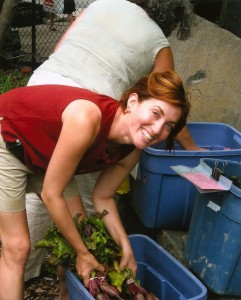 When I set out to eat almost exclusively food grown within 250 miles of New York City, I had a lot of questions. I knew that eating a local-foods diet would reduce my carbon footprint as well as support small local farms and the local economy. I knew from my visits to farmers markets and from growing vegetables in a community garden how fabulous fresh food picked at its peak could be. But…
When I set out to eat almost exclusively food grown within 250 miles of New York City, I had a lot of questions. I knew that eating a local-foods diet would reduce my carbon footprint as well as support small local farms and the local economy. I knew from my visits to farmers markets and from growing vegetables in a community garden how fabulous fresh food picked at its peak could be. But…
All of the other locavores I’d read about, including Barbara Kingsolver and Michael Pollan, had advantages over me when it came to eating local. They lived in a mild climate with a longer agricultural season, or had huge gardens or even farms. What I wanted to find out was could it be done by someone living in a tiny apartment on a limited budget, and with a hectic, multi-employer urban lifestyle? And what would I eat in winter?
I discovered that it is completely possible to eat a deliciously varied and healthy local foods diet in NYC without breaking the bank or requiring a 28-hour day. Local, organic food can be pricey, but it doesn’t have to be. There are ways to make a local foods diet almost as convenient as picking up the phone to order takeout or delivery.
Read More
Posted in Learning Experiences, People on July 21 2009, by Plant Talk
 |
Ashley Burke is a second-year student in the School of Professional Horticulture. She is doing her required six-month internship at the High Line in Manhattan, a recently completed elevated public park built on a former rail bed. The School’s internship program is designed to allow students to synthesize and apply what they’ve learned, expand their skills by providing further training in a professional horticulture venue, and expose them to the multiple facets of the field. Ashley sent us this report. |
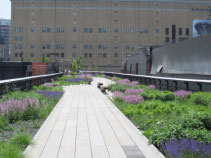 Interning at the High Line, a park on the Lower Westside of Manhattan that opened on June 9, has given me an unparalleled opportunity to observe and learn about how a city park is created.
Interning at the High Line, a park on the Lower Westside of Manhattan that opened on June 9, has given me an unparalleled opportunity to observe and learn about how a city park is created.
I began working at the park in mid-April and as such, have been exposed to various elements of the process. Some of my responsibilities have included compiling a master plant list; verifying what has been planted; creating plant identification cards to be used by the public, with plant names, cultural information, native range, and where it is located in the park; and even selecting horticulture tools. Of course, I also had hands-on plant work: The week before opening, we raced against time to weed, water, and prune to get the park ready for visitors.
I also worked extensively with the plans that were drawn up by the landscape architects, field operations, and the landscape designer, Piet Oudolf (who co-designed the current Seasonal Walk at The New York Botanical Garden), and this has allowed me to familiarize myself with the plants being used. Part of this has been to check that each plant species is properly identified, the name is spelled correctly, and that the plants are located where they are indicated on the plan. Through my experiences, I am learning that one cannot design properly without being able to identify the materials one works with.
Read More

 I must admit I groaned a little when Martha told me that she had agreed to redesign the herb garden at NYBG as part of The Edible Garden summer-long exhibitions. I’m not a big fan of herbs: They aren’t the most visually interesting plants, being mostly fine textured and green-gray. To top it off, the existing features at the location such as the shrubs, trees, and paths would dictate so much of the design.
I must admit I groaned a little when Martha told me that she had agreed to redesign the herb garden at NYBG as part of The Edible Garden summer-long exhibitions. I’m not a big fan of herbs: They aren’t the most visually interesting plants, being mostly fine textured and green-gray. To top it off, the existing features at the location such as the shrubs, trees, and paths would dictate so much of the design.













